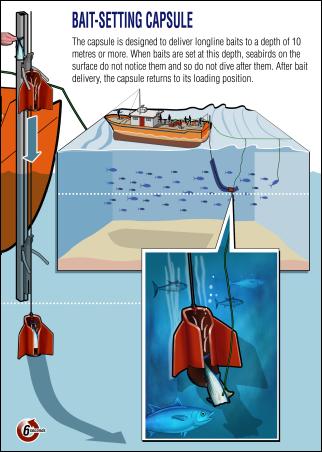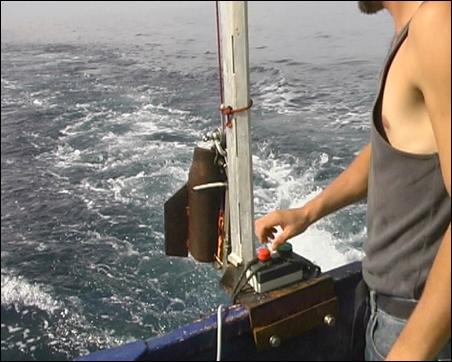Seabird Device To Be Tested
Seabird Device To Be Tested
A device with the potential to save the lives of thousands of seabirds will be put to the test in Australia shortly.
New Zealand inventor and fisher, Dave Kellian, has spent the past eight or nine years developing a machine that can set baited hooks 10 metres underwater.

Dave Kellian inside the capsule
“It’s like a sewing machine except the needle is 10 metres long,” he says.
“You put the bait at the top of the stroke and when it gets to the bottom it releases the bait before returning to the top. It mightn’t look very pretty but it’s easy to operate, it doesn’t interfere with other fishing practices, and it has the potential to save lots of birds.”

Seabirds are accidentally killed in the course of commercial fishing when they dive on baited hooks in their search for food.
The fishing industry, government departments and a number of environmental groups formed an alliance last year called Southern Seabird Solutions to promote fishing techniques which reduce the chances of seabirds being caught.

Dave Kellian is a member of Southern Seabird Solutions. Last year he attended the second International Fishers Forum in Hawaii and met an Australian tuna fisher who expressed interest in his experimental underwater bait-setting capsule.
“The guy was really enthusiastic. He kind of threw himself at me and said: I don’t care what it takes, let me get involved, we’ve got to solve this thing. I took his name and number and then kept thinking about it when I got home to New Zealand. Eventually I rang him and told him that I want to test the capsule and get some hard data out of it. He said: right, what plane can you get on?”
Mr Kellian says the tuna fisher operates just north of Sydney and he expects to go there within the next week or two to begin trials of the underwater capsule. If these trials are successful, he believes the capsule will be ready for manufacture.
“I’ve been fishing all my life, and my dad was a fisherman too. I’ve caught my share of seabirds over the years and I’m not proud of that. I guess it was just ignorance, but now I’m really committed to finding a solution for this problem.”
Mr Kellian developed the initial prototype of the capsule with the assistance of a Warkworth engineering firm. Much of the past eight or nine years has been spent testing and refining the device. One of the challenges was finding out how far underwater the baits should be set. Mr Kellian experimented by releasing bags of pilchards at increasing depths.
“The birds readily dived to eight metres but once I released the pilchards at 10 metres they didn’t even bother trying. It became pretty obvious over the course of these trials that 10 metres needed to be the benchmark for the bait-setting capsule.”
The device was tested most recently on a New Zealand fishing boat, Daren Coulston’s ‘Gold Country’, at sea off the coast of Napier late last year. A Kaikoura-based eco-tourism company, Oceanwings, has also thrown its weight behind the capsule, with owners Dennis and Lynette Buurman selling hundreds of t-shirts to tourists on their seabird-encounter trips and then donating the profits to the capsule’s development.
The convenor of Southern Seabird Solutions, Janice Molloy, who also coordinates the Department of Conservation’s seabird conservation programme, says the capsule could be used by fishing companies around the world if trials show that it is effective at reducing the number of seabirds killed.
“We’re really excited by the possibilities and we appreciate the energy, time and money which Dave has put into developing this device,” she says. “We’ll now just have to await the results of the Australian trial to see how it effective it is.”
A number of measures
already exist to reduce the likelihood of seabirds being
caught. These include the use of: bird-scaring lines to
keep seabirds away from the sinking baits, blue-dyed bait
(for some reason the birds appear not to recognise the
bait), devices to set fishing lines underwater, loud sounds
and bright lights to scare away the birds, weights attached
to the fishing lines so that baits sink faster, and
night-setting so the baits are less visible.


 NZ Trucking Association: TruckSafe New Zealand Set To Transform Transport Sector
NZ Trucking Association: TruckSafe New Zealand Set To Transform Transport Sector Commerce Commission: ComCom Caps Chorus’ Revenue At $4.1 Bn For Next Regulatory Period
Commerce Commission: ComCom Caps Chorus’ Revenue At $4.1 Bn For Next Regulatory Period Science Media Centre: Meth Use Skyrockets – Expert Reaction
Science Media Centre: Meth Use Skyrockets – Expert Reaction MBIE: Snapshot Of Te Ōhanga Māori 2023 – The Māori Economy 2023 Report
MBIE: Snapshot Of Te Ōhanga Māori 2023 – The Māori Economy 2023 Report Consumer NZ: Consumer NZ’s 2024 Sunscreen Database Launches - A Powerful Tool For Safer Sun Protection
Consumer NZ: Consumer NZ’s 2024 Sunscreen Database Launches - A Powerful Tool For Safer Sun Protection National Cyber Security Centre: Reports Of Cybercrime On The Rise - Keep Them Coming
National Cyber Security Centre: Reports Of Cybercrime On The Rise - Keep Them Coming



